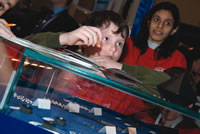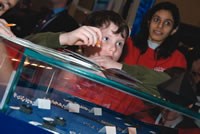
Learning about diamond prospecting might not sound like a normal part of high school, but that's what thousands of students are doing across the country, thanks to the Mining Matters program, an initiative of the Prospectors and Developers Association of Canada (PDAC).Discovering Diamonds, a curriculum designed for Grade 12 students, teaches kids about diamond-bearing deposits, diamond formation, and the modern technology used for the discovery, extraction and processing of diamonds.
“For example, one of the activities that we have uses data from the Ontario Geological Survey, where they've gone into the James Bay Lowlands and done a sampling program for kimberlite indicator minerals,” said Laura Clinton, director of Mining Matters.
“When modelling it in the classrooms, students would be broken into 10 exploration teams, and are each given the background that 95 samples out of 105 have been analyzed for kimberlite indicator minerals, and you are responsible to analyze the remaining 10.
“The students have these bags of sand that the teachers make up, and in the bags they put little beads, which represent indicator minerals. The kids have to sift through them, pick and count the beads, and map these last sites.”
Mining Matters, established in 1994, is a registered charity dedicated to educating students about Canada's geology and mineral resources. The program, which has reached 400,000 children over the years, also has curricula for children in Grade 4 and Grade 7.
David Gallant, a geography teacher at Espanola High School, uses the Discovering Diamonds curriculum for his Grade 11 students, and the Mining Matters II - The Earth's Crust curriculum for his Grade 9 students, although it is actually designed for students in Grade 7.
“In Grade 9, you're teaching the geography of Canada, but it's great to get into basic igneous, sedimentary and metamorphic rocks. We use the rock kits just for some hands-on stuff in the classroom,” he said.
“We also have the Discovering Diamonds kit for the senior geography classes. The resources are built ready-to-go for the classroom. They are so handy, current and practical. That makes them even more valuable.”
It's important to teach students about mining, especially in a community like Espanola (70 kilometres west of Sudbury) which is surrounded by mines, and has recently suffered the effects of a downturn in the pulp and paper industry, Gallant said.
“It's not just some obscure topic in the classroom. It's a potential career path that they make a connection to and express an interest in,” he said. “Each year for the last couple of years, we've sent three or four kids towards post-secondary mining programs.”
Unlike the Mining Matters high school program, which is available across Canada, the elementary school programs are currently only accessible by teachers in Ontario, although Clinton is hoping to expand them to Manitoba in the near future.
Mining Matters II - The Earth's Crust, designed for children in Grade 7, explores the theory of plate tectonics, earthquakes, volcanoes, geothermal energy, rocks and minerals, the Earth's resources, soils and Ontario's geology. Students use hands-on materials like 72 rock and mineral samples and sampling equipment.
The Ontario government recently revised the Grade 7 curriculum to have less of a focus on plate tectonics, so Clinton is currently re-working the teaching materials for this grade level.
Deeper and Deeper, designed for children in Grade 4, investigates the importance of rocks, minerals and soil in our lives, as well as how humans can both minimize changes to the landscape and adapt to these changes.
Although some other industries do provide teaching materials about their areas of interest, very few adhere to the government curriculum like Mining Matters does, said Clinton.
Teachers are expected to attend a training workshop before using Mining Matters, she said.
“It's very hands-on so that the teachers experience the unit and all of its components,” Clinton said. “For Discovering Diamonds, we might set up six stations throughout the workshop area, where teams of teachers complete a single activity, and then present that activity to the rest of the group.”
Because it's not possible for teachers working in remote aboriginal communities to attend workshops, Mining Matters has an educator who travels to these schools. Eleven communities have been visited in the past year, she said.
“The educator flies into the communities and she's usually there for a couple of days,” said Clinton.
“She volunteers her time in the school for one of the days, delivering fun, hands-on workshops with the kids, and in the evenings after school, the teachers, educational assistants, and interested community members attend workshops on delivering the curricula.”
At the PDAC International Convention, Trade Show and Investors Exchange, which took place in Toronto from March 2-5, Grade 4 students from two Toronto-area elementary schools using the Mining Matters curriculum took part in special programming.
Seventy teachers also attended a training workshop during the convention.
The students learned about the equipment an exploration geologist uses, brought in their favourite rock samples to see if they could stump a geologist, did chocolate chip cookie mining and received a guided tour of the trade show floor.
They also listened to a Toronto-area musician named Chris Rawlings perform songs he has written about mining and geology.
“It's really hard to find a performer who sings about living on a layer cake, and the swirls of silver and gold found in the Canadian Shield. He also uses the words precambrian and brachiopod. It was really, really good,” said Clinton.



